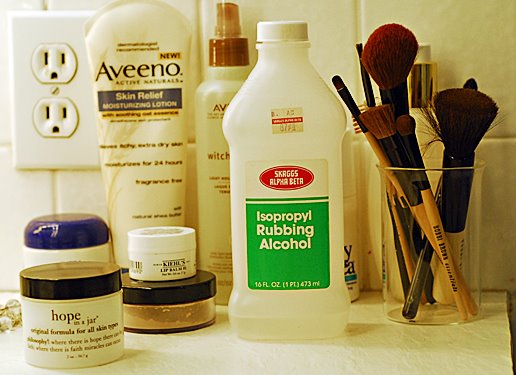Difference Between Rubbing alcohol and Vinegar
Alcohol and vinegar are two common materials that people use for cleaning purposes. Although cleaning and removal of stains is not the primary use of the mentioned materials but they are very good at it owing to their chemical properties. For example, vinegar is acidic and can dissolve some stains or materials. It is common practice to use one of these for cleaning home appliances and furniture such as TV screens, LCDs, metal surfaces, wooden surfaces and so on. Rubbing alcohol is not exactly the same as common alcohol although chemically, it is an alcohol. Also, it is different in its composition, mode of action and application to vinegar.
Rubbing alcohol is also known as surgical spirit. Most people recognise it as a liquid that is prepared and used primarily for topical application. Its preparation involves the use of a special denatured alcohol solution. Moreover, it contains approximately 70% by volume of ethyl alcohol, or concentrated ethanol. The same is also known as isopropyl alcohol or isopropanol. Manufacturers, industrial as well as individual use various formulation standards whereby different ethanol contents are used. The normal composition ranges from about 70% to 99% of alcohol. Rubbing alcohol is colourless and has a melting point of -89 degrees centigrade. Its boiling point is 82.5 degrees centigrade.
Let us also look at the chemical composition of vinegar. It is a liquid that consists of acetic acid and water. The simple molecular formula of acetic acid is CH3COOH. Its production involves fermentation of ethanol by a specific strain of bacteria. The main use of vinegar is as a cooking ingredient. Commercially, the production of vinegar is by fermentation that can be fast or slow. The slower processes are for traditional vinegars and the fermentation process proceeds for as long as a number of months or even a year. The other method, that is, the longer fermentation is unique in the sense that it allows the accumulation of a slime that is nontoxic. This is composed of the same acetic acid bacteria. In the fast method, the bacterial culture is added to the source liquid initially after which air is allowed for a process known as oxygenation. This promotes faster fermentation. The average production time for vinegar in the fast process is from twenty hours to three days. Commercial vinegar that is produced by the fast process contains residual alcohol.
As mentioned above, both rubbing alcohol and vinegar are good at getting rid of stains but they have different mode of actions. Rubbing alcohol is the better option if only non-polar compounds need to be dissolved. This includes oil. For stains caused by oil, rubbing alcohol can be used as an effective solution. Vinegar, on the other hand, is good at dissolving both, polar as well as non-polar compounds. It can dissolve salts and sugars.
When non-polar compounds need to be dissolved in order to clear stains, many people prefer vinegar due to some characteristics that it exhibits. It does not evaporate quickly and depending on the concentration of acetic acid, can dissolve greater and more rigid stains.
A lot of care needs to be taken when using either of rubbing alcohol or vinegar. Both, in high concentrations, can be harmful. In this regard, rubbing alcohol poses a greater risk as it is toxic to ingest and also releases greater fumes as concentration is increased further. It should be used in a well ventilated area. Vinegar should also be used with care but is not as harmful as rubbing alcohol could be.
Summary
- Rubbing alcohol is also known as surgical spirit, is prepared and used primarily for topical application, its preparation involves the use of a special denatured alcohol solution, contains approximately 70% by volume of ethyl alcohol, or concentrated ethanol, also known as isopropyl alcohol or isopropanol; Vinegar is a liquid that consists of acetic acid and water, the simple molecular formula of acetic acid is CH3COOH, Its production involves fermentation of ethanol by a specific strain of bacteria
- Rubbing alcohol is the better option if only non-polar compounds need to be dissolved such as oils; vinegar is good at dissolving both, polar as well as non-polar compounds, it can also dissolve salts and sugars
- Vinegar does not evaporate quickly and depending on the concentration of acetic acid, can dissolve greater and more rigid stains
- Rubbing alcohol is more harmful than vinegar; but both need to be used carefully
- The difference between Royal icing and Buttercream icing - March 22, 2015
- Difference between stuffed and deep dish pizza - March 21, 2015
- Difference between Crane and Heron - March 20, 2015
Search DifferenceBetween.net :
 Email This Post
: If you like this article or our site. Please spread the word. Share it with your friends/family.
Email This Post
: If you like this article or our site. Please spread the word. Share it with your friends/family.
2 Comments
Leave a Response
References :
[0]https://www.flickr.com/photos/rutlo/3198806471/



Ethyl and isopropyl alcohol are not the same. Ethyl alcohol is CH3CH2OH, an alcohol group on ethane. Isopropyl alcohol is CH3CHOHCH3, an alcohol group on the second carbon of propane.
Summary:
Ethyl alcohol (ethanol): 2 carbons
Isopropyl alcohol (isopropanol): 3 carbons
If rubbing alcohol can kill this covid 19 virus, how about the other component that can be swallowed like vinegar,product like wine or spirits liqour.maybe it can kills also this virus. Just thinking